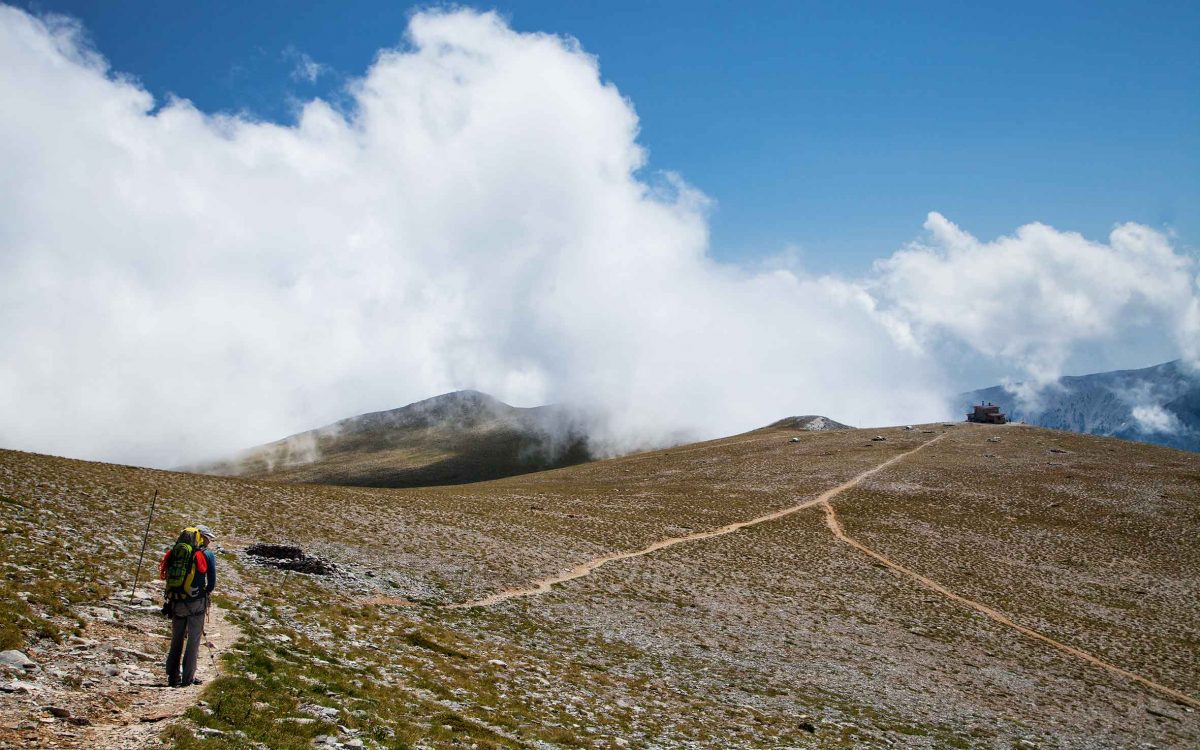Why would someone want to climb the three highest peaks of Mount Olympus in one day? “Because they can,” answers my friend and mountain guide Nikos Lazanas, owner and founder of the outdoor adventure company ED+. We burst out laughing, and continue the ascent towards the Kofto trail, surrounded by wild boar tracks and the tall trees known locally as robola pines, as we artfully avoid analyzing why so many mountaineers constantly feel the need to set new goals.
“If you walk quickly, we might make it to seven of the highest peaks,” Nikos teases. This is something he has already done – and others, too, I assume. I pick up the pace, but not to make it to three or seven peaks today; we’re planning to climb them tomorrow instead. No, I’m anxious to reach the Plateau of the Muses, from which we’ll be able to see enchanting Stefani, the throne of Zeus. If we can reach it by sunset, we can watch the shadows grow longer, making the jagged rocks seem even sharper when seen from the mountain refuge where we’ll stay.
Here, the stars always seem brighter than anywhere in the world. Mt Olympus is my own Everest, and it’s my annual “tama” (pledge or promise to myself). I come here once a year to push myself psychologically and physically, as hard as I can. I always leave the mountain changed. (Some sources claim that “mountain” is the actual meaning of the name Olympus, hailing from a pre-Hellenic word. I love this idea, and the thought that, when you say “mountain,” you’re actually referring to Mt Olympus.)
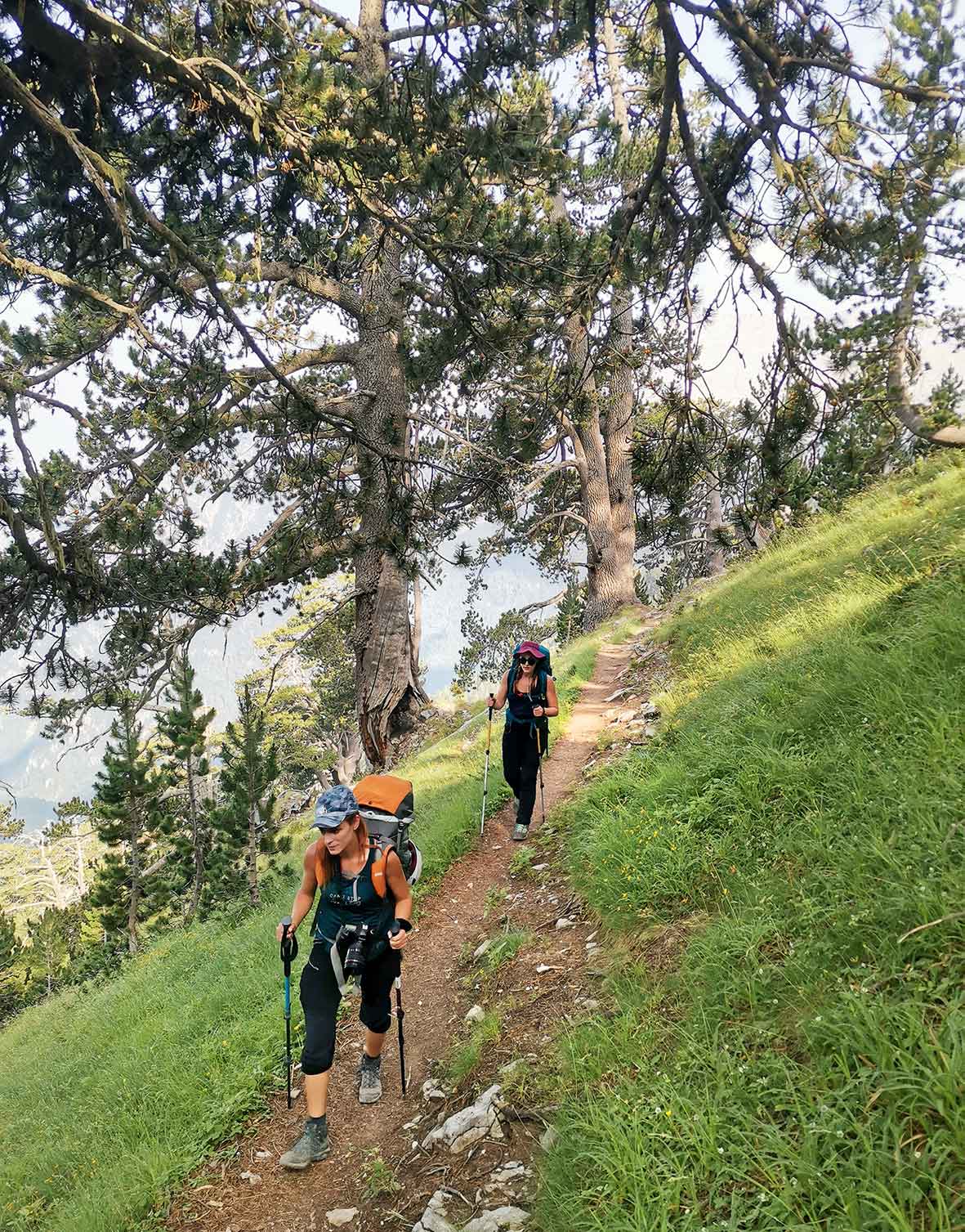
© Olga Charami
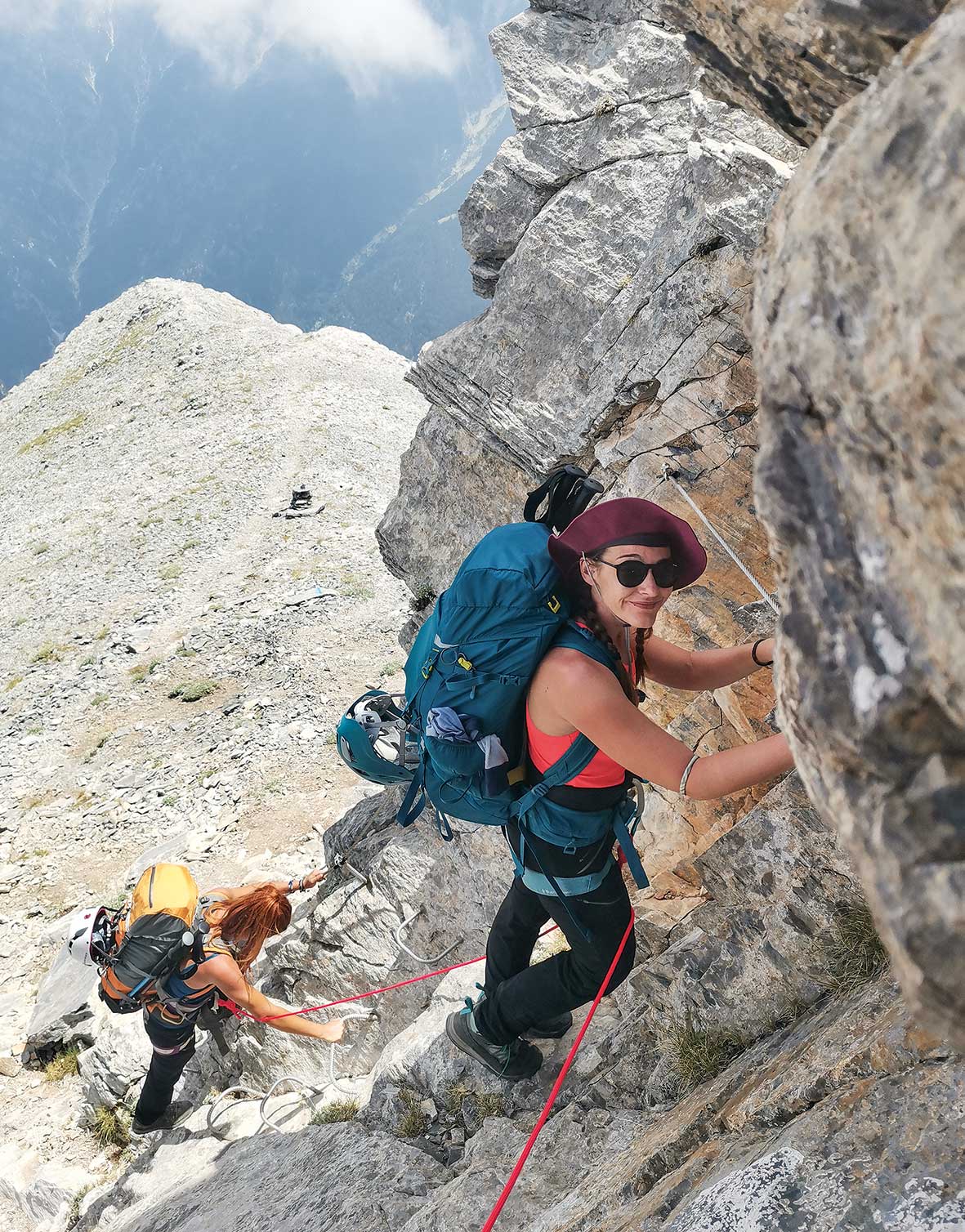
© Olga Charami
Skirting the edge
It’s the next morning and, after a good night’s sleep in the Giosos Apostolidis mountain refuge and some strong coffee on the veranda there, we’re on the trail early. “Did you make it at your first go?”, asks a young man who’s just returning to the Apostolidis refuge after a failed attempt to climb the couloir at Mytikas. We reassure him he’s not the only one. He relaxes a little and starts describing how sheer and dangerous the couloir seems.
I know what he means. Mt Olympus is not child’s play, and climbing to the Mytikas and Stefani peaks involves difficult mountaineering techniques that are beyond the ability of many visitors. Nonetheless, it’s estimated that 5000 people climb Mytikas, the highest peak in Greece (2919 meters), each year via the couloir, a steep “staircase” that requires climbers to use their hands as well as their feet, on weathered rock covered in scree and worn slippery and smooth by countless footsteps. Even when those in the lead are very careful, they’re likely to precipitate rock falls, the cause of most accidents here. Helmets and hiking shoes are necessary, and the use of ropes and a mountain guide is also recommended. Still, every year the couloir is packed with young hikers not equipped with ropes or, even worse, with tourists without helmets and in flip flops, accompanied by tour guides from any one of a number of companies that don’t even supply their customers with safety harnesses.
Many visitors don’t even know that night temperatures, even during the summer months, drop so low that winter jackets and isothermic clothes are needed. It’s worth pointing out that there are significant differences between mountain guides, mountain chaperones and, of course, those who call themselves experts. As with all outdoor activities, it’s a good idea to confirm who’ll be with you and to check their credentials, too. That being said, most people climb Mytikas without the help of an expert – the greatest challenge is perhaps not physical but psychological, as you venture to dizzying heights.

© Olga Charami
On the way to Natsis Pass
We ascend via the Stefani Couloir, crossing the traverse leading from the plateau. We greet people heading to Mytikas across the way before we reach the pre-summit and climb the last, more technical section to the peak at 2909 meters. It’s not easy to describe what I’m feeling. For long stretches I’m walking on the edge of the cliff, overcoming a sense of vertigo. If you’ve never climbed a high mountain before, all I can say is that you really do feel as if you’re dangling over the void. I film a video for my Instagram story, because what I’m seeing can’t be conveyed by or condensed into a single photograph. The video records the panorama of peaks around me; the plateau with the two mountain refuges far below; mystical Kazania, a valley from where thick blankets of fog emerge; and the Mytikas peak opposite, surrounded by alpine-like landscapes. My voice sounds rather bewildered: “We’re on Mt Olympus,” I mutter, “but the trademark sight of the Stefani is missing from the shot. Why? Because we’re standing on its peak.”
Stefani may be the most demanding peak on Mt Olympus, but it isn’t the highest. The mountain trail towards that summit lies right before us. It’s called Natsis Pass, “because old Kostas Natsis created it in the 1930s to connect the two peaks. He did it without the technology we have today, and completely alone,” Nikos tells me, as I gulp in awe. Natsis’ endeavor was the first successful solo feat of this magnitude undertaken by a Greek, in Greece. All previous attempts had failed.
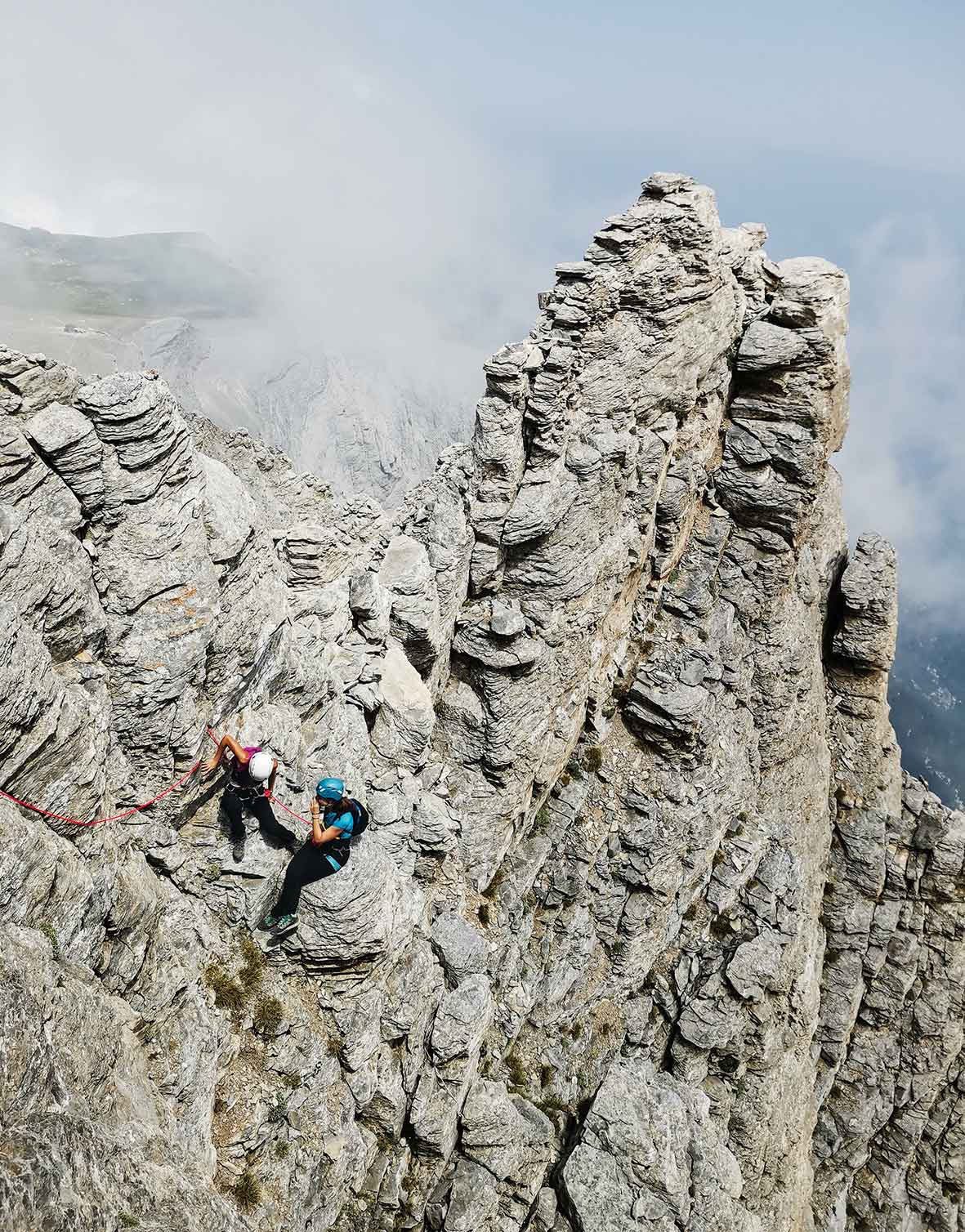
© Olga Charami
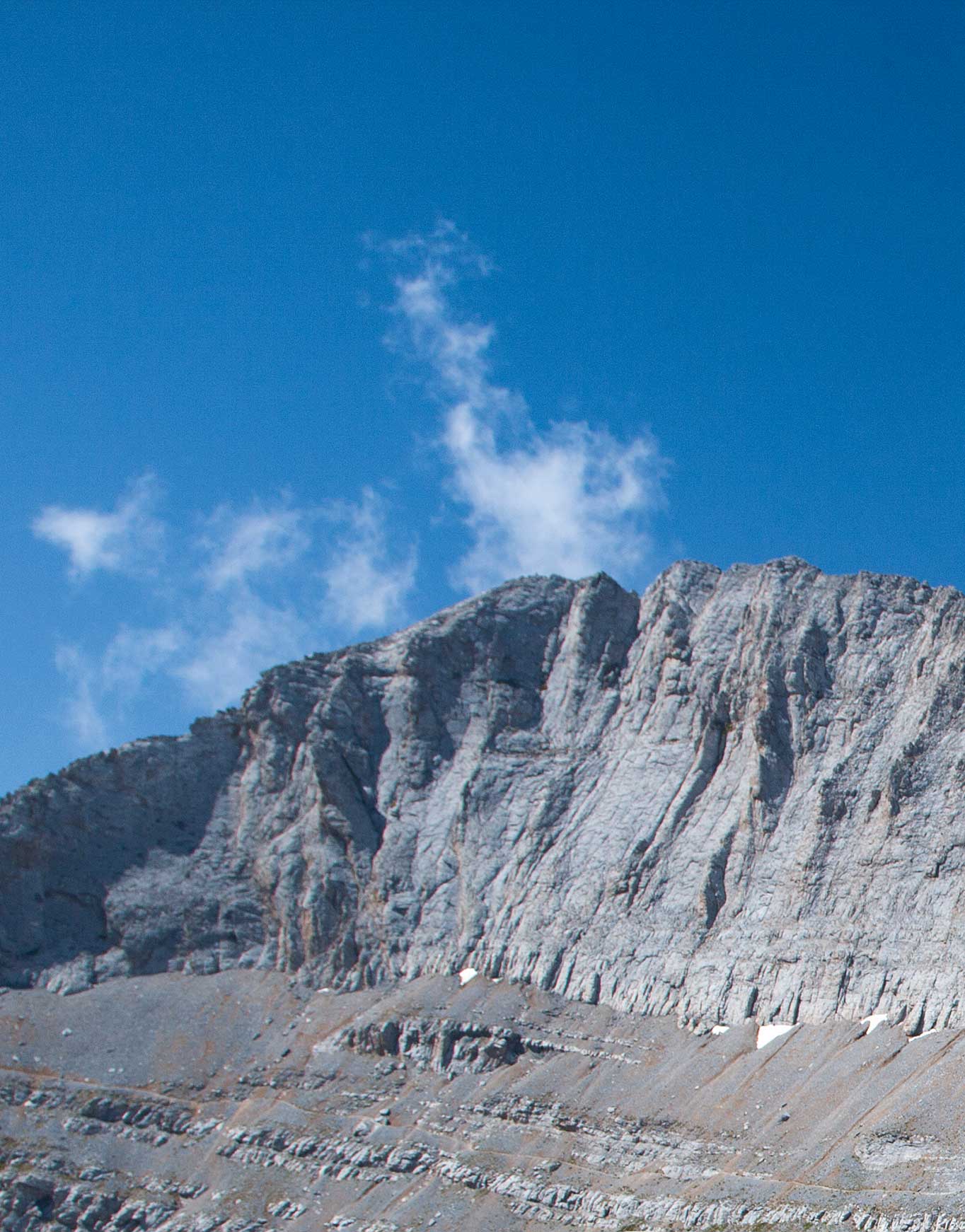
© Olga Charami
For expert climbers, Natsis Pass is a low-difficulty climbing trail, but it nonetheless involves going up and down stone “steps,” squeezing in between rocks, clambering over boulders, traversing sections as you step on slivers of earth while literally hanging over the edge of the cliff, and some regular one-foot-in-front-of-the-other climbing as well. It’s an awe-inspiring game in a chilly grey labyrinth that makes an enemy out of your own breath; with fog hurtling up the famed Kazania Valley via the Strivada Couloir, you feel so small, it’s almost overwhelming.
We search for the trail following the few safety grips along the way. “Think about how he would have gone, and you won’t get into trouble in these challenging passages,” Nikos says, as he secures our line with reassuring frequency, using the crevices in the rock – a lesson I won’t forget to emulate, and a confirmation of the soundness of my decision to come here with a professional mountain guide.

© Olga Charami
Silence, respect, awe
And so, coming via the more challenging route and not from the couloir, we arrive at Mytikas, the highest peak in Greece. I do not celebrate. I do not take any pictures. I do not think of anything. I just gaze at the immensity stretching out before me. This transcendental experience makes us fall silent. The beauty of this very different perspective is beyond us. Thankfully, we’re only sharing the peak with a single subdued couple, who are probably feeling the same way. At this moment, I simply could not stand anyone carrying on or cheering about their “conquest.” Dimitra, my rope companion, wordlessly extends the peak logbook so I can write my name in it. I couldn’t care less.
We descend via the route called Kakoskala, similar to the couloirs, heading west. As we exit onto the pass, we hike the easy trail to the third peak, Skolio (2912 meters). After the previous two peaks, Skolio seems sedate. And yet, if this were the only peak you climbed, and you found yourself gazing out at the endless alpine landscape with Agios Antonios Peak on one side and the jagged rocks of Mytikas and Stefani, the Kazania Valley, and the Kopsi Naoum route on the other, you’d be awe-struck by what you were seeing. The downside: since Skolio is easily accessible from the path leading from the Agapitos mountain refuge, many people come here, and some even think it’s cool to cover the rocks in graffiti tags.

© Olga Charami
Although the return to the plateau is long, with several difficult spots, including the famed Zonaria section, for those who suffer from fear of heights, I feel a sense of relief. After climbing three peaks, this seems like a piece of cake. I ‘m also relieved this is a weekday. During the summer weekends, too much human traffic can create an atmosphere that seems to lack respect for this site, the first National Park in Greece and a UNESCO Biosphere Reserve that’s on track to be given UNESCO World Heritage status, a step which might save it from many current threats. (The idea of issuing tickets to hikers, raised recently, is potentially another major development. A change that’s already taken place is the erection of a new 4G tower in the area; it saddens me that some visitors are now more mesmerized by their phones than by the scenery.)
Today, just before sunset, there aren’t many people at the Giosos Apostolidis mountain refuge as we return. Three peaks in one day should really be enough for me, but we notice that everyone is getting ready to head out. It’s the time of day when everyone makes for the two “small” nearby peaks of Profitis Ilias and Touba to enjoy the sunset (from the plateau itself, only the amazing sunrise is visible). Of course, these peaks only appear to be small; they are, in fact, 2803 and 2801 meters high respectively but, from the Giosos Apostolidis refuge, they seem like gentle hills. Which one boasts the best sunset? Which one is the shortest climb? The only way to find the answers is to attempt them both. And, since we’re pressed for time, instead of hiking we engage in some… mountain running.
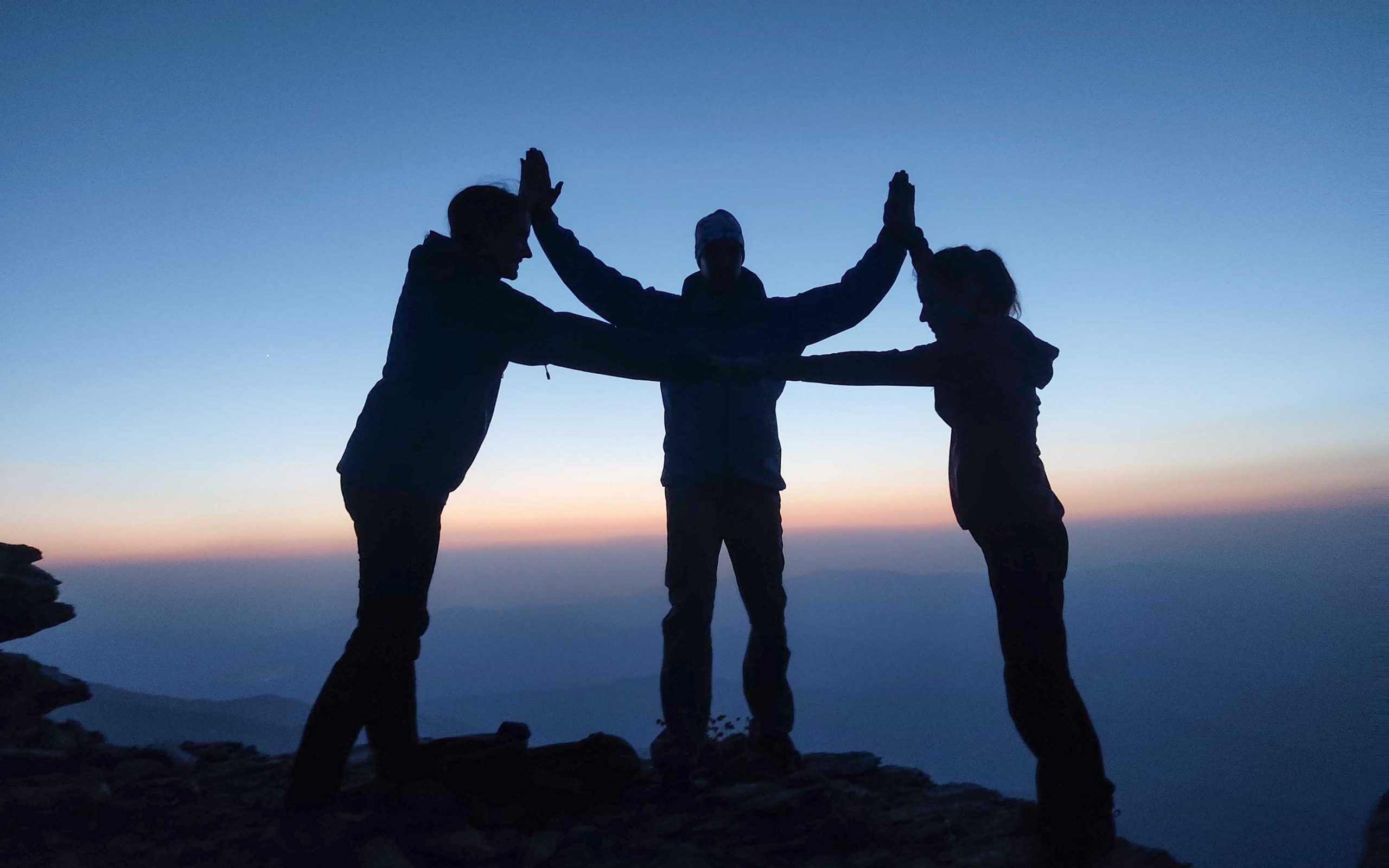
© Olga Charami
On Profitis Ilias, an ancient chapel’s mere presence is enough to move me. They say Saint Dionysios of Olympus built it in 1550; that’s why he’s considered Mt Olympus’ first explorer. (They also say couples who marry here are fated to separate!) We reach Touba’s summit in 15 minutes, as long as it took us to dash up Profitis Ilias. It’s dusk, and from here, we can see Stefani face-on in an alternative, yet equally magical, perspective. As it grows darker, we watch the moon rising next to us, above Kazania, the plateau, and all of Pieria. It seems to be illuminating all of Greece.
We head back down to the refuge with moonlight to guide us. As I climb into my dorm bed, I ask “Was that it? What ‘s left to look forward to?” Nikos replies with a question of his own: “Do you see now why mountaineers keep setting new goals?” Without waiting for an answer, he zips up his sleeping bag and falls into a deep sleep. I lie there staring at the stars and the outline of Stefani, faintly illuminated by the moonlight. As my eyes close, I decide that the mountain will remain an annual goal, a tama, for me. Even if I never scale its peaks again, I will always find my way back to its slopes and plateaus.
ΝΟΤΕΒΟΟΚ

© Olga Charami
• The season on Mt Olympus begins in May-June, when the refuges open, and usually finishes when they close, in November, depending on the weather and snowfall.
• Agapitos, Petrostrouga, Gomarostalos, Kopsi Naoum, Kofto: these are just a few of the dozen approaches to the mountain, each with a different difficulty level – the first two are the easiest. All of them begin in forested land, with thick vegetation and wildflowers. Depending on your stamina, it will take 5-7 hours to reach the plateau, where you will most likely spend the night. The next day is usually reserved for reaching the peak, multiple peaks or other climbing activities.
• Nikos Lazanas is a mountain guide, owner of ED+, member of the Hellenic Mountain Guides Association and trainer at the Hellenic Federation of Mountaineering & Climbing. He will lead you safely to the plateau via whichever route you choose, and take you to your peak of choice or on any other adventure you’d like. (Tel. (+30) 694.521.1766, edplus.gr)
• The hiking map published by Anavasi on a scale of 1:30,000 (including Mytikas on a scale of 1:10,000) is particularly helpful.
• It’s worth visiting the web site mountolympussummits.com, a project put together by photographer Babis Giritziotis, with impressive 360° views from the highest peaks.
• The historic mountain refuges Giosos Apostolidis (Tel. (+30) 23510.828.40) and Christos Kakkalos (Tel. (+30) 23521.000.09) operate on the Plateau of the Muses, and cost €13 per person per night (€11 for members of mountaineering clubs). The kitchen opens at 06:30 and shuts at 21:00. Lights out at 22:30. Even though it is quite big, the Apostolidis refuge is definitely the quieter of the two; the chances are fair you’ll run into a mini-party at Kakkalos.
• To break up the hike into two days, you can stay at a lower elevation at Spilios Agapitos refuge (Tel. (+30) 23520.818.00) or at Petrostrouga refuge (Tel. (+30) 697.724.6350).
• We recommend the boutique hotel Robolo in Litohoro for stays before or after the ascent (Tel. (+30) 23523.067.15, from €80). The special care shown by owner Roula Malti, the calm and relaxing atmosphere in this 19th century structure and the attention to detail (Coco-mat sleeping systems, hearty breakfasts, an exceptional wine list, and modern comforts) are perfect, either for powering up before the climb, or for winding down afterwards. For food, the Gastrodromio en Olympo (Tel. (+30) 23520-21300) has been a local favorite for years. Alternatively, there are many meze tavernas to choose from, either on the main thoroughfare or in the Lakkos neighborhood.

